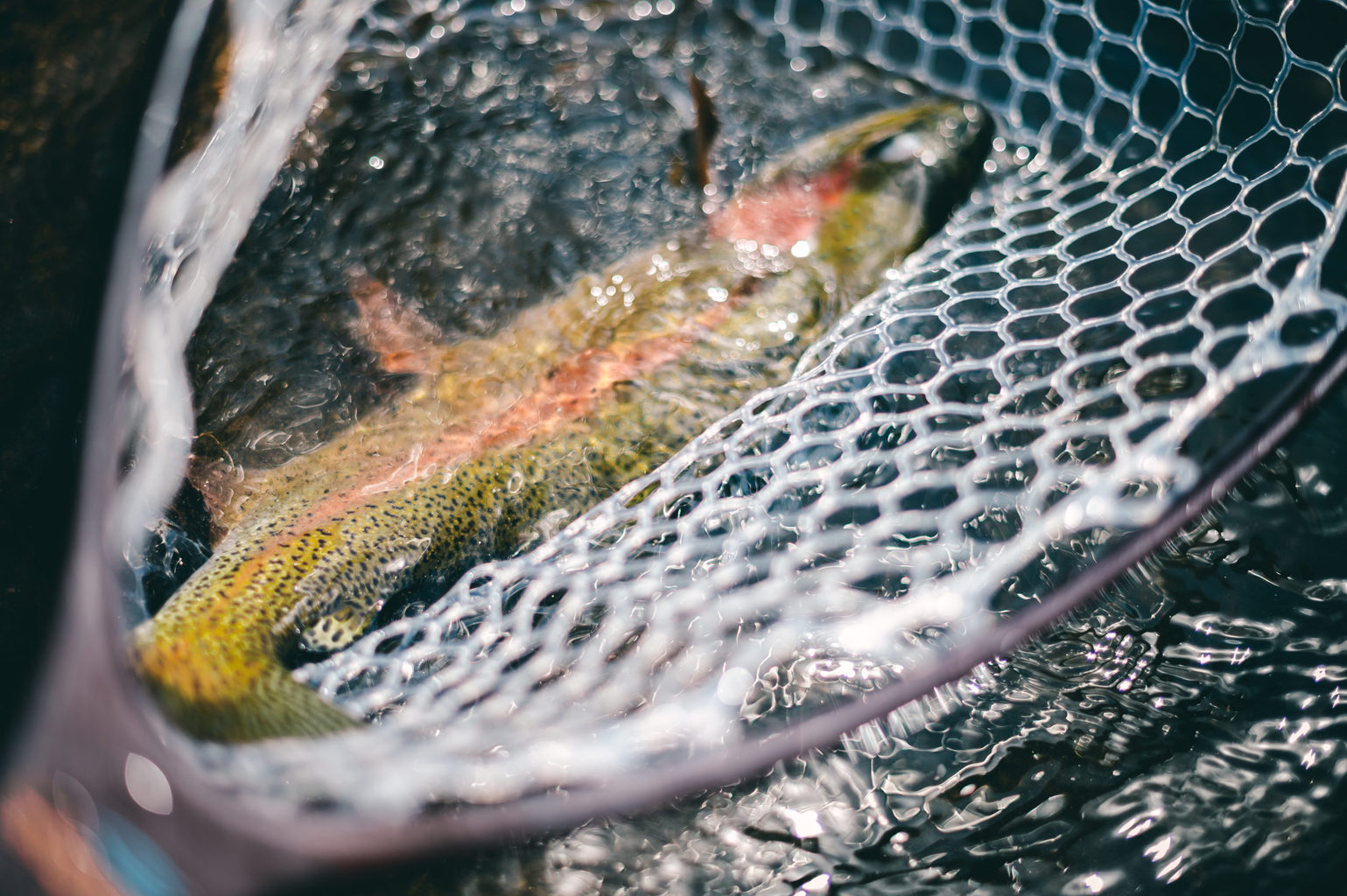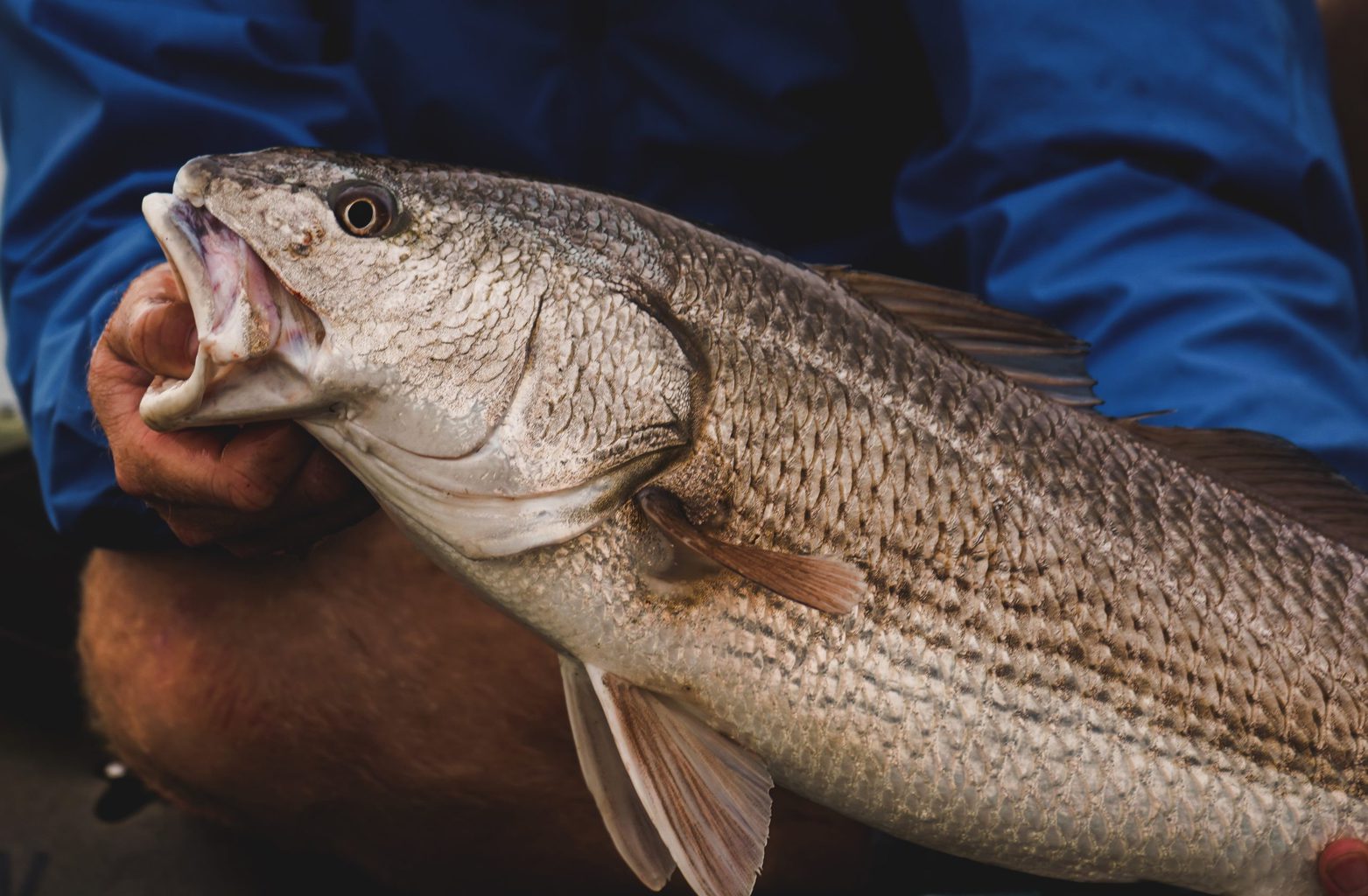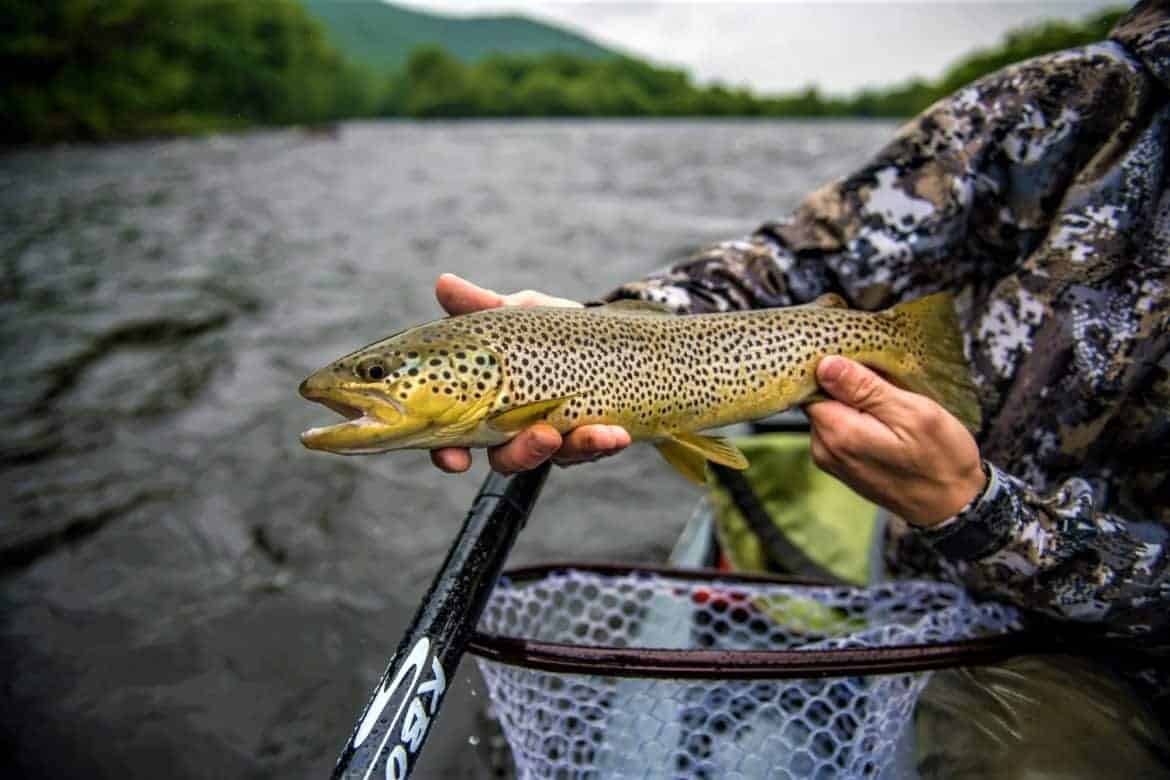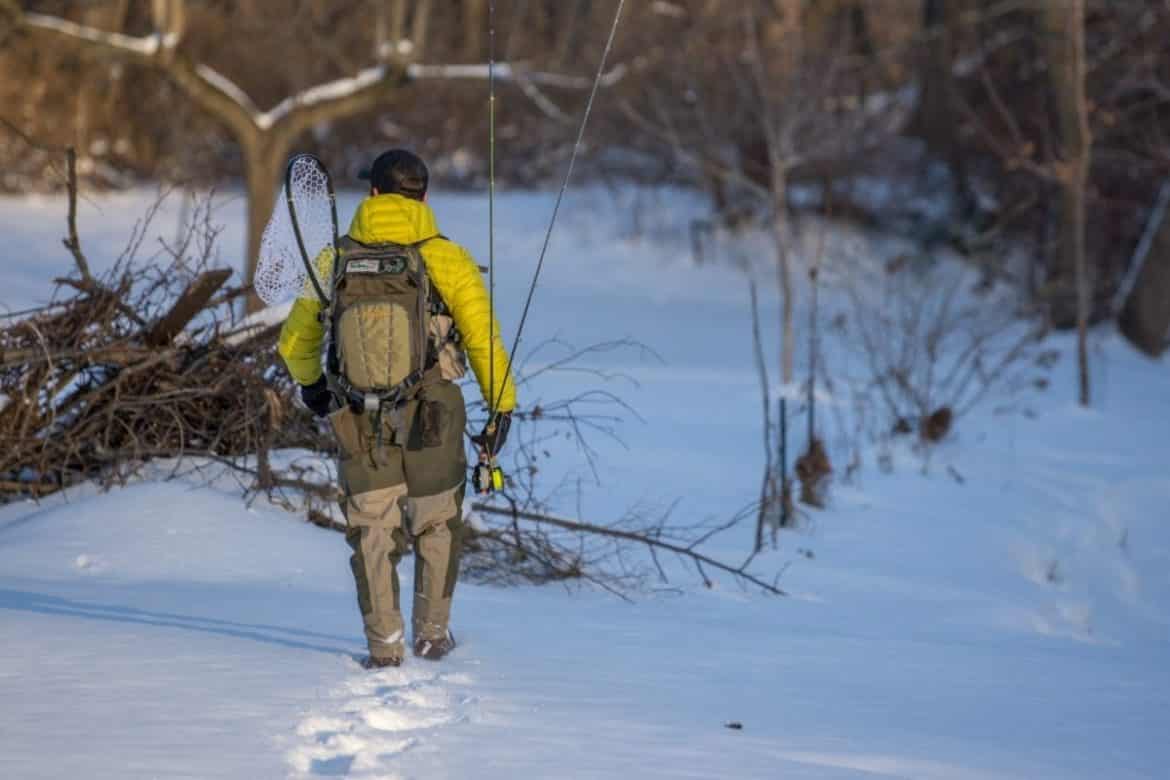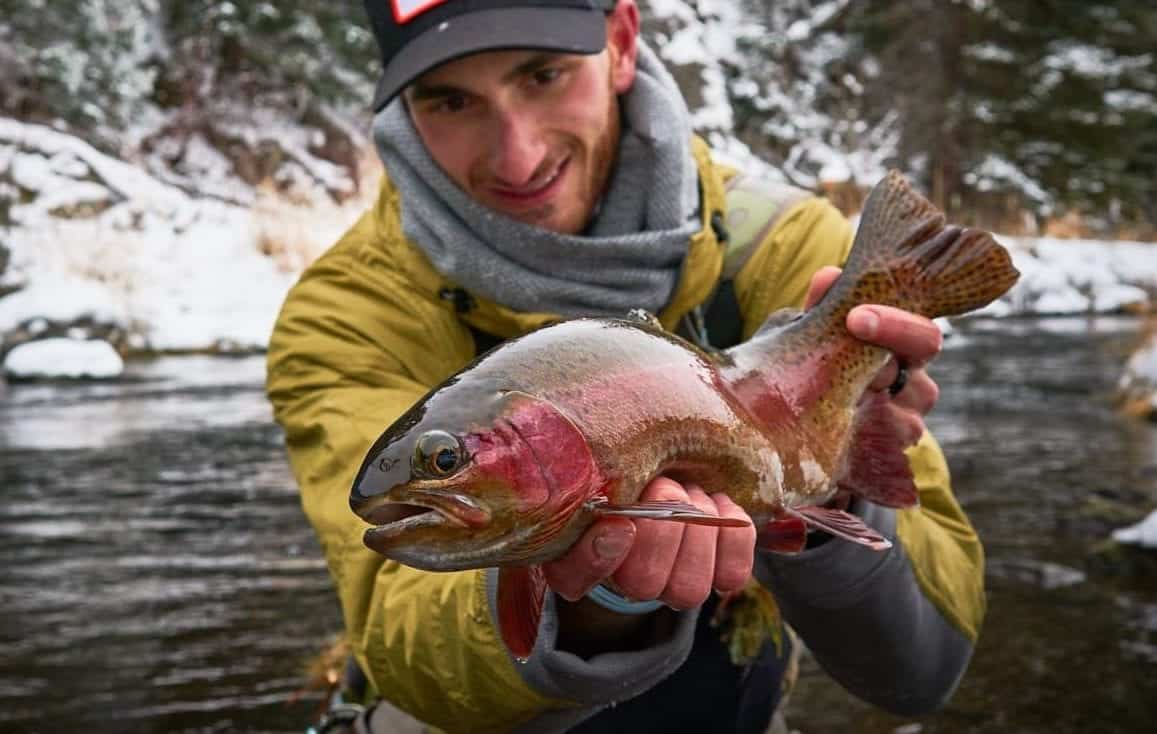24 Best Fly Fishing Flies For Trout
There are many different types of flies to choose from when fishing for trout. Innovation in trout flies change year to year, and many patterns that were once hot trout flies, don’t work as well as they use to.
Innovation in the fly tying world continues to push the envelope in fly design. New materials, new tying methods, and of course new fly tyers innovate new designs effective at catching fish. Some patterns are better then others, and sometimes, a fly pattern will work on one body of water but not another. Having confidence in the flies you choose comes from spending time on the water and experience. The goal of this article is to discuss fly patterns that work historically well, and flies that I would always carry in my fly box when guiding.
My goal here is to help you have a better understanding what flies to choose when you make your selection prior to a fishing trip, the methods best used for presenting various fly patterns, and finally, the patterns themselves. Below are patterns I would never leave home without. Of course, this is all my own opinion, experience from my time spent on various rivers in the Western United States. Every angler has fly patterns that work well for them in conditions on their home waters.
Table Of Contents
- Factors to Consider When Choosing Trout Flies
- Best Nymph Flies
- Best Dry Flies
- Best Terrestrial and Foam Flies
- Best Streamer Flies
Factors to Consider When Choosing Trout Flies
Before choosing flies for trout fishing, it is wise to consider a few questions to make the best choice when picking flies.
A few points to consider:
What type of water will you be fishing: back country freestone rivers or tailwaters? Do you expect to encounter specific species of insects hatching? What time of year is it: spring, summer or fall? Have you fished this particular piece of water before, or is this a totally new river? Are you fishing a heavily pressured river, where trout see lots of flies? What are the weather conditions: cloudy or sunny? All of these points should be considered prior to choosing the best flies for a trip. At the very least, answering some of these questions should give you a better idea of what patterns might work well. Let’s break down these points piece by piece, and consider these external factors in greater depth.
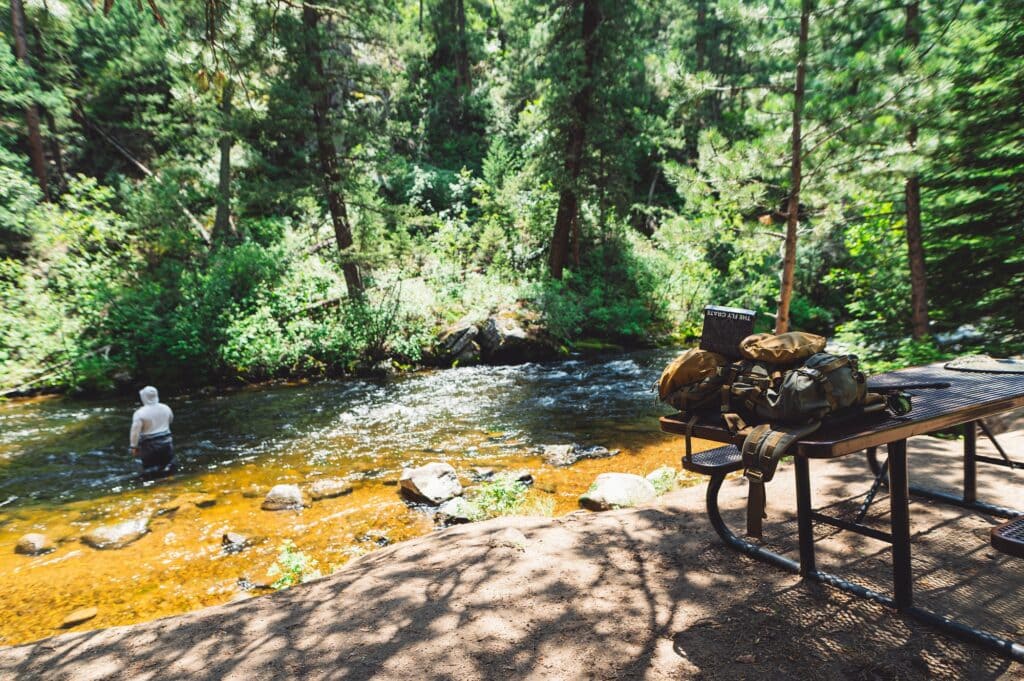
Tailwater or Freestone stream?
Both types of rivers can be technical fisheries when it comes to specific insects hatching. For freestone streams or rivers, taking note of the rivers altitude is important. The higher the stream in elevation, it is likely the less selective the fish are going to be. High altitude freestone streams typically have colder water and a steep gradient with fast moving currents. This makes fish less selective for several reasons.
At higher elevations, insect hatches are minimal due to the cold water. There is simply less food choice and oftentimes shorter seasons. Fish cannot afford to be selective.
In addition to cold water, high altitude rivers typically have a steeper gradient. Fast water means trout have less of a chance to inspect flies. The window to see a fly, make a decision, and then eat it is very short. In these conditions, flashy attractor patterns grab a fish’s attention.
As a river descends in altitude, the water slows and warms giving more opportunities for insects to hatch. In addition, lower altitude rivers typically provide easier access for anglers and an increase in fishing pressure. Therefore, trout see many varieties of insect hatches and lots of fly fly patterns too. Lower elevation water moves slower and has a decreased gradient. Trout have the opportunity to inspect flies before eating them. It is in these areas that anglers should use imitative fly patterns that match specific hatches and the life phases of those hatches.
Recommended Reading: How Do You Match Flies to the Hatch?
New River or an Old Haunt
We all have our home waters, or areas that we fish a lot. We become familiar with the rhythm of the fish and the insects that hatch there. For familiar waters, I like to carry a few flies that are impressionistic in nature, generic fly patterns that cover multiple insect species at once. An example of imitative fly would be the hare’s ear. The hare’s ear could be a caddis or it could be a mayfly. Regardless, it is buggy and it covers many insects at once. With few imitative flies in the fly box, I stock up on imitative patterns for specific hatches I know I will see. Imitative patterns are flies that match specific insects. Examples of these fly patterns, would be the split case P.M.D. or the Juju Baetis. With a few well chosen impressionistic fly patterns, and lots of imitative specific hatch flies I am prepared for anything I might see on the water.
If you are fishing a river that you have never been to, and are not sure about what hatches you will encounter, then choose more impressionistic fly patterns and a few imitative patterns based on the time of the year. You can never go wrong with a variety or hare’s ears, pheasant tails, and parachute adams. These flies cover lots of different insect species and will catch fish in 95% of the situations that you will encounter. Having these flies in your fly box will have you prepared for most hatches that you may encounter on a fishing day, even if you have no idea what those might be. I like to carry sharpie pens, so I can color my flies to match any color insect might encounter.
Fly Size and Time of Year
Fly size is critical when selecting flies and being successful at trout fishing. As a general rule of thumb, in early spring you will want to choose larger flies for trout. In the spring, trout are coming out of winter hibernation and rainbow and cutthroat trout are getting ready for the spawn. Runoff is also occurring, so larger high calorie food items in the river system. Food items in the spring may include: leeches, eggs, worms, stoneflies, and cranefly larvae. These are large insects, and your flies your should match the same size.
Once summer starts and the mayfly and caddis fly hatches are underway, start with larger flies and gradually down size as the summer moves on. Insects typically hatch with the larger generations first. The bugs gradually become smaller as the hatch continues through the summer months. For example, the P.M.D. hatch on Idaho’s South Fork of the Snake will start in July. In July, I prefer to fish size 14 P.M.D. dry fly patterns. By the end of August, I am typically fishing size #18 dry flies and nymph patterns for the same hatch. The insects become smaller as the summer progresses.
Of course in the fall, the egg bite picks up, sow bugs are always available and midges become a main food source for many trout. Most hatches are concluded, and until the brown trout start to spawn, or October caddis start appearing, the action can really slow down. Once brown trout start to spawn, predatory brown trout will chase a large trout streamer, and fish will start to eat in preparation for the winter months.
Recommended Reading: Fly Fishing Hook Sizes: How To Choose The Right Size
Weather Conditions
Weather conditions play an important role in what fly you might choose for a day on the water. If you are expecting a cloudy overcast day, then make sure to bring plenty of dry fly patterns and emerger patterns. Cloudy days with increased moisture will prolong hatches and insects will spend more time on the surface of the water drying their wings. This will bring big fish to the surface.
In addition, this is an excellent time to cast a trout streamer for large brown trout. This is especially true in the fall. Large brown trout that spend the majority of their life in dark lakes will move into river systems that are brighter and less comfortable. Dark skies will coax these fish out from deeper lies to eat. This is your chance!
With our crash course in fly pattern selection, here are some of my favorite fly patterns that I would not leave home without.
Best Trout Nymphs
Nymphs or wet flies are flies that are fished subsurface. Trout eat most of their food underwater, so fishing a nymph subsurface is a great way to match aquatic insects in the nymphal and emerger stages. While nymphs are not sexy like dry flies or streamer flies, nymphs produce lots of fish. Nymphs can be tied weighted or unweighted, and the most typical method of fishing them is dead drifted, deep in the water column, and under a strike indicator. Here are a few of my favorites.

The Rainbow Warrior
The Rainbow Warrior is an attractor fly that is flashy and grabs fish’s attention. The rainbow warrior is an excellent fly choice for prospecting for trout before, during and after hatches. It does have the profile of a mayfly, so it can match emerging mayflies or midges with it’s flashy silver tinsel. The flash imitates a mayfly or midge trapping air bubbles between the nymphal shuck and skin to help them swim to the surface of the river. Fish key in on this behavior.
It is a weighted fly. It is typically fished underneath an indicator. It can also be fished with a dry dropper setup. This is one of the best flies that works well during hatches and when there are no hatches at all. I prefer to carry them in sizes #14,#16, and #18.
Recommended Reading: How To Fly Fish Midge Flies

The Lightning Bug
The lighting bug is very similar to the rainbow warrior. It is bright and flashy. Unlike the rainbow warrior which is tied traditionally in pearl, the lightning bug is usually tied in silver or gold. Most of the time I like to keep a good assortment of both gold and silver lighting bugs in my fly box. They both work equally well, but in my experience many rivers where there are large populations of yellow sallys the gold variety works well. It is tied both weighted and unweighted, but I prefer the weighted version.
Fish lightning bugs before and after hatches. I almost always fish them deep, drifted naturally, and under an indicator. Once a mayfly hatch starts, switch to an imitative fly pattern. Usually, after the hatch has concluded the lightning bug will continue to catch fish.

The Mop Fly
The mop fly is an incredible fly pattern that often seems to put fish into a feeding frenzy. Nobody knows for sure what it is supposed to imitate, but one thing is for certain it catches fish. I like the mop fly in all different colors. Fluorescent green, bright orange, white, and tan all work well at catching fish.
You can fish the mop in many different ways, and I have seen many anglers fish it as a dry dropper. My preferred method of fishing the mop fly is under an indicator in a two fly setup. I use the mop fly as my point fly in a two fly deep nymph rig. It is an excellent fly to fish year round, but bright colors work really well in spring runoff. If you want to eliminate catching small fish, tie a 3″-5″ version of this fly. Nymph it deep. Big fish love it.
Recommended Reading: How To Fly Fish A Two Fly Setup

Jig Head CDC Pheasant Tail
The jig head cdc pheasant tail is one of my favorite nymph flies for trout fishing. It works almost everywhere. The jig hook helps this fly ride upright and reduces snags. Tied with a tungsten bead head, the fly gets down into the strike zone. Most mayflies and lots of caddis fly species are brown in nature, so this fly covers many hatches at once. The CDC soft hackle collar traps air bubbles, moves naturally, and is perfect for simulating emerger insects.
The CDC jig head pheasant tail can be nymphed deep or fished as a dry dropper. I prefer both methods. It is my go-to in a dry dropper rig in July and August. Fish are looking up and often times this pattern suspended below a Chubby Chernobyl is ultra productive.
Recommended Reading: How to Fly Fish Grasshopper Flies and Terrestrials

Pat’s Rubber Leg
Don’t leave home without it. Pat’s rubber leg is one of the most productive fly patterns year-round for me. It gets deep, catches fish, and imitates larger stoneflies that are always in the river. No matter what trout species you are targeting, if stoneflies are a significant source of food, then fish this pattern.
Pat’s Rubber Legs can be fished as a dry dropper or deep under an indicator. My favorite all-around version of this fly is a double heavy size #6 in orange or brown. As the summer progresses, downsize to #8’s and #10’s. Don’t be afraid to fish two of these in a two-rig tandem nymph setup under an indicator.
Recommended Reading: How to Catch Trout on Stoneflies


Split Case P.M.D. or Split Case B.W.O.
The split case series of mayfly nymphs are very productive fly patterns. These are imitative fly patterns that imitate the emerging portion of both Pale Morning Dun mayflies and Blue winged olive mayflies. The split case P.M.D. is tied with black biots, and a small foam wing case in yellow. Meant to imitate an emerging mayfly splitting out of its nymphal shuck, the small hotspot triggers strikes. This fly is tied in both weighted and unweighted versions. Both work equally well.
While I have caught many fish nymphing this fly deep. My favorite way to fish the split case is to use the unweighted version of the fly in a two fly setup behind a dry fly. Dressing the nymph with a small amount of floatant. The fly hangs in the surface film and will fool just about any fish that won’t eat a proper dry fly.
Andy’s Hunch Back Infrequence
This fly was created as a replacement for often-seen pheasant tails. Often times fish will become accustomed to common wet flies like the pheasant tail. This fly solves that problem, by imitating both P.M.D. and Blue winged olive hatches. This is the right fly to choose when trout stop eating an over-fished pattern.
I like to fish this fly in the same manner as the split case pattern above. It produces many strikes when fish are actively rising to mayflies in the adult stage. Fished just in the surface film, fish have a hard time refusing this pattern.
Recommended Reading: What’s An Emerger Fly And How Do I Use Them?

Perdigon
The perdigon has its origins in European competitive fly fishing. There are many different types of this fly that are all effective at catching fish. Tied on either a jig hook or standard nymph hook this pattern is mostly a just thread sealed with resin. The minimalist design allows for less water resistance. Thus, these styles of wet flies get to depth very quickly. Regardless of what trout species you fly fish for, getting your flies down in the water column is key.
The Perdigon can be fished in any manner: under an indicator, European tight line nymphing, or as a dry dropper. My favorite way to fish these flies for trout is under a piece of foam. My most productive manner of fishing them is when mayflies or caddis are hatching, and drifting them off the back sides of shelves.
Recommended Reading: How To Fly Fish Euro Nymphs

Zebra Midge
The zebra midge is critical to any fly box. There is no other food source that is available to trout year round. Often overlooked and underrated, midge hatches provide fishermen with ample opportunities to catch fish all day after the more popular mayfly and caddis fly hatches conclude. They are also a critical food source for winter trout.
Zebra midges can be fished under an indicator or as a dropper in a dry dropper rig. My favorite time to fish the midge patterns is during the winter months. That being said: black, red, and brown zebra midges are very effective nymphed deep in the summer months late in the afternoon. While the main hatch is over, midges will be present all day. Fish will switch to the most available food source, and often times it is subsurface midges.
Recommended Reading: 10 Great Multiple Fly Rig Setup Combinations For Trout

Squirmy Worm
I love worm flies. My favorite worm fly is squirmy worm jig head fly. The heavy tungsten bead and natural look of the squirmy worm is a fish catching machine. This fly pattern will work year round, but it really shines during spring runoff.
The squirmy worm fly pattern has a large profile and it gets down deep. This is important during spring runoff as the water is usually off-color. Worms are important this time of year, because rising water will flush banks and force stream side annelids into the river system. Tied in pink or brown, this worm fly really catches fish when nymphed under an indicator in tandem with an egg pattern.
Recommended Reading: How to Fly Fish Squirmy Wormy Flies For Big Trout
Best Trout Dry Flies
Dry flies are flies that float on top of the water. They can match emergers, adults, and crippled aquatic insects stuck in the surface film. When it comes to trout flies there are many effective patterns, but the ones listed below are my favorite.

Elk Hair Caddis
The elk hair caddis is one the most important dry flies for trout. Although it is an imitative fly pattern, it can cover many different hatches depending on what colors you carry. It can be trimmed and fished during mayfly hatches. Tied in tan or yellow it can double as a yellow sally, and of course, it covers many different species of caddis. The elk hair caddis is one of those must have trout flies.
You can fish the elk hair caddis in many different ways. Fished as a single dry fly or in tandem in a two dry setup as a trailer on a large piece of foam is effective. It can even be sunk and swung like traditional soft hackle wet flies.
Recommended Reading: How to Fly Fish Caddis Flies
Harrop’s CDC Biot Mahogany Dun
This sparsely tied fly incorporates cdc into the fly pattern and is effective at tricking picky trout accustomed to inspecting dries. The CDC Biot Mahogany is one of my all-time favorite flies.
The CDC Mahogany Dun sits low in the water and imitates an emerging mayfly stuck in the surface film of the river. As far as trout flies go, this one does an outstanding job covering multiple mayfly hatches. Most mayflies are brown, so the correct color in conjunction with the natural movement of the cdc wing creates a realistic fly. This is usually the second fly I cast to rising fish. Start with a true dun imitation. When the fish stop eating it or refuse it, present this fly next and it usually results in a hooked fish.

Parachute Adams
When fly fishing a new river, it is always wise to carry an excellent all around dry fly pattern that is proven to work on many different types of streams. The Parachute Adams covers many aquatic insects found in trout streams around the world.
I prefer to carry many sizes of this fly in a neutral grey color. Then, using various permanent Sharpies, I can match hatches in size and color by simply coloring the fly. If the bite is really difficult you can even cover the fly purple, making it even easier for trout to see.
Recommended Reading: What Color Variations You Should Use For Fly Fishing Flies And When


Baetis Cripple or PMD Cripple
Cripple patterns are critical trout flies that will help fly fishers fool the most weary of trout. Baetis and P.M.D cripple patterns imitate aquatic insects that have become stuck in the surface film of the river or cannot get out of their own pupal or larvae shuck. Trout rarely pass on such an easy meal.
Fly fishing with these patterns are much like poker players saving their best cards for the right moment. When all other fly patterns fail to produce fish, cast a cripple pattern. Fish that refuse emergers and dry flies will typically eat a cripple pattern, and this can extend the dry fishing for several more hours.

The X Caddis
The X caddis is a non hackled, low riding version of an elk hair caddis. It is meant to imitate emerging caddis pupa. This is a great fly for prospecting.
I prefer to fish the x caddis in riffles, along the banks, and especially in slow circulating back eddies. Caddis are one of the most prevalent bugs on the water, so it is never a bad idea to fish these in the summer months.
Best Terrestrial and Foam Flies For Trout
Foam flies for trout are used to imitate large terrestrial insects like grasshoppers. They can also be used imitate stoneflies and salmon flies. They are excellent at floating a heavy nymph, and are very important when fishing dry dropper rigs.

Chubby Chernobyl
The Chubby Chernobyl is my favorite foam fly for fly fishing. It floats a heavy nymph, can be fished in rough water, and is super durable. The poly wing can be dressed with float-ant and lasts all day long. It can represent many other terrestrial insects depending on the size and color you choose. Plus, the Micro Chubby Chernobyl is fantastic in small streams and backcountry creeks as an ant, caddis fly, stonefly, and terrestrial pattern.
Gee’s Supafly
This is my all time favorite golden stone and salmonfly imitation. It is a buggy fly tied with a Don King wing that almost sticks up vertically. This gives the fly a sparse realistic appearance, but it can still float a nymph in a dry dropper rig.
The Water Walker
The water walker is one of the most productive foam flies on the market. The thin foam wing and low profile give this fly an extremely realistic appearance when skated across the water. It is sometimes difficult to tell the difference between real salmon flies or stoneflies and the water walker. It pushes water well when twitched, and big brown trout will often key into this behavior.

Stream Bank Hopper
The stream bank hopper should be fished in the hottest months of the summer. It is an effective grasshopper pattern. Terrestrial insects are an important part of trout’s diet especially late in the summer when other hatches begin to wane. Fish this pattern tight to grassy banks.

Amy’s Ant
Amy’s Ant is a good all around foam pattern. When carried in different sizes it covers grasshoppers, stone flies, and of course ants. having a solid foam pattern that will cover many different insects is always a wise move.
Best Streamers For Trout
Streamers are fly patterns that typically imitate crawfish, minnows, and other game fish. They are used to fool fish effectively all year long. Typically, larger fish are caught on streamers in the spring and fall.

Woolly Bugger
The woolly bugger is a classic trout streamer that works in a variety of water types. It also catches many different species of fish. Whether you fish them in lakes, small streams, or large western rivers, woolly buggers work. In a pinch, you can even nymph them too. There are many variations of this classic fly pattern.
Recommended Reading: How to Fly Fish a Woolly Bugger Fly

Galloup’s Sex Dungeon
The Sex Dungeon was one of the fist articulated flies for trout that I had ever seen. Kelly Galloup is a streamer master, and it is from him that this fly originated. The Sex Dungeon pushes water well, and flutters like a real baitfish. I prefer the dungeon in the colors: natural, white, or olive. The orange variety is a very good crawfish imitation to when fished on a sinking fly line.
Recommended Reading: Fly Fishing Streamer Flies: Everything You Need To Know
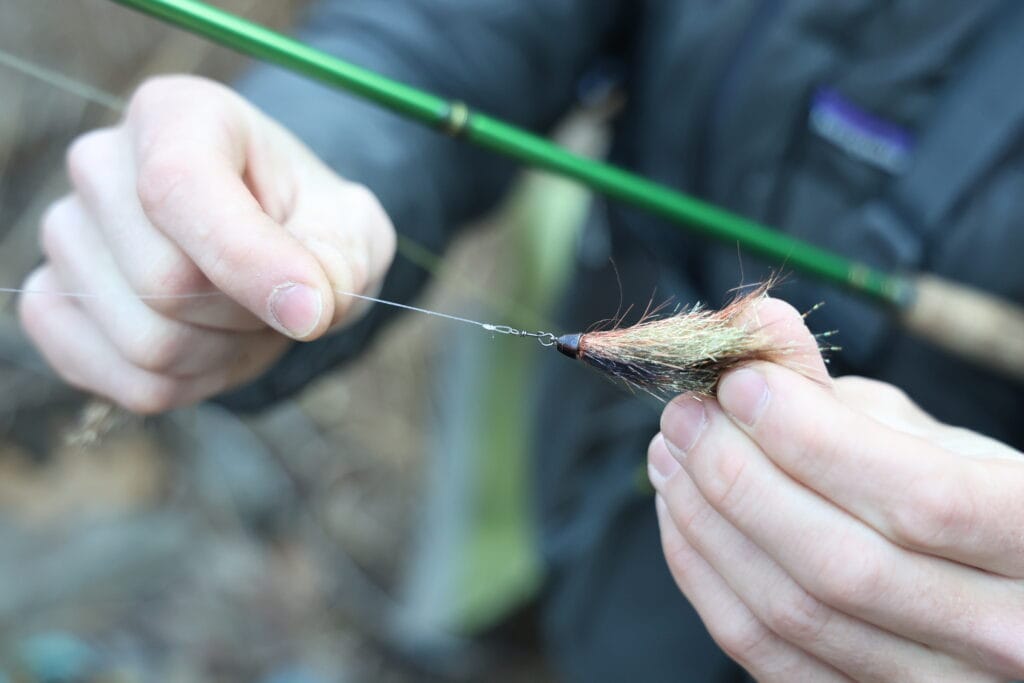
The Sparkle Minnow
The sparkle minnow is one my favorite streamer flies for trout. The tungsten cone head and bright tinsel material make this fly loud and flashy. It works very well during spring runoff. When fished with a sinking fly line, it really gets deep. Getting streamers down into the strike zone is critical in rivers where the current is moving very fast. This is the fly for those conditions.
Double Bunny
This large streamer pattern is effective at grabbing fish’s attention with an incredible amount of natural movement. The rabbit fur strips give this streamer realistic swimming action. It works well when fished like a normal streamer, but it can also be nymphed deep to target big fish. This is a great tactic to try below dams. Baitfish come through the dam gates and float stunned and helpless. These are perfect targets for predatory trout.
Fly Fishing Made Easy 👍
Our Quarterly Fly Club ships 1,000’s of flies to anglers all across the United States. Receive curated fly assortments selected for the season with in-depth articles on how to fish them. Great for beginners to learn and for intermediates to discover new flies.






